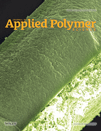Improved synthesis of a branched poly(ethylene imine)-modified cellulose-based adsorbent for removal and recovery of Cu(II) from aqueous solution
Abstract
This study focuses on an improved synthesis of a branched poly (ethylene imine) (PEI)-modified cellulose-based adsorbent (Cell-g-PGMA-PEI). We aim to improve the adsorbent capacity by reducing side reaction of epoxide ring opening during graft copolymerization of glycidyl methacrylate (GMA) onto cellulose which increases the content of epoxy groups, anchors to immobilize branched PEI moieties. FTIR spectra provided the evidence of successful graft copolymerization of GMA onto cellulose initiated by benzoyl peroxide (BPO) and modification with PEI. The amount of epoxy groups of Cell-g-PGMA was 4.35 mmol g−1 by epoxy titration. Subsequently, the adsorption behavior of Cu(II) on cell-g-PGMA-PEI in aqueous solution has been investigated. The data from the adsorption kinetic experiments agreed well with pseudo-second-order model. The adsorption isotherms can be interpreted by the Langmuir model with the maximum adsorption capacity of 102 mg g−1 which was largely improved compared with the similar adsorbent reported. The dynamic adsorption capacity obtained from the column tests was 119 mg g−1 and the adsorbent could be regenerated by HCl of 0.1 mol L−1. Results indicate that the novel pathway for the synthesis of Cell-g-PGMA-PEI exhibits significant potential to improve the performance of adsorbents in removal and recovery of Cu(II) from aqueous solution. © 2012 Wiley Periodicals, Inc. J. Appl. Polym. Sci., 2013




